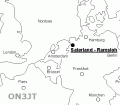The VLF transmitter DHO38 is a transmitter for VLF of the German Navy near Saterland, West-Rhauderfehn, North-Germany. It is used to transmit coded orders to diving submarines of the German Navy and of Navies of other NATO-countries. DHO38 transmits since 1982 on 23.4 kHz with a power up to 800 kilowatts. DHO38 uses an umbrella aerial, which is carried from 8 steel tube masts with a height of 352.8 metres. Each pylon stands on a huge ceramic ball, which serves as an insulator for a voltage of 300 kilovolts.
The text written above is the one you’ll find if you did a search on Google for DHO38. I also wonder if everyone copies from another :-).
In the last sentence they all suffer the same spelling mistake : … a huge ‘cermacic’ ball…
And that’s about all I could find.
Searching for more information I found this :
DHO38 is located in North-Germany, near the town Ramsloh.

I have found two pictures about the antennas. The picture on the left comes from the site http://www.frequencymanager.de/ and is copyrighted by Roland Prösch.
The other pictures here were found on the site http://www.wikipedia.org/ and shows the antennas from different angles. The pictures are shot by Christian Brinkmann.
 You could try to receive this station by using the mic/line input of the soundcard of your computer.
You could try to receive this station by using the mic/line input of the soundcard of your computer.
Your soundcard must be capable of sampling at 48 kHz, if 44,1 kHz is the highest sample rate , the max receive frequency is then half of it or 22.050 kHz.
Connect a long wire to it and use Spectrum Lab from DL4YHF.
I monitored their signal strength from sunday 27th (Easter 2005) of march till 28th of march with SpecrumLab and plotted it out on a chart. Used my vlf loop connected to the mic input of my laptop.
![]() Using the Watch List and Plotter I made the following plot.
Using the Watch List and Plotter I made the following plot.
The signal drops a bit around 19:15, increases again. Another drop just before midnight.
Monday morning between 9:00 and 10:00 the station went down. Most likely for maintenance. When back on the air, the signal is a bit stronger then before.
Plotting the signal strength of a vlf transmitter is what some people do detect SIDs. SID stands for Sudden Ionospheric Disturbance. I’ll have to collect more info on that subject later.

